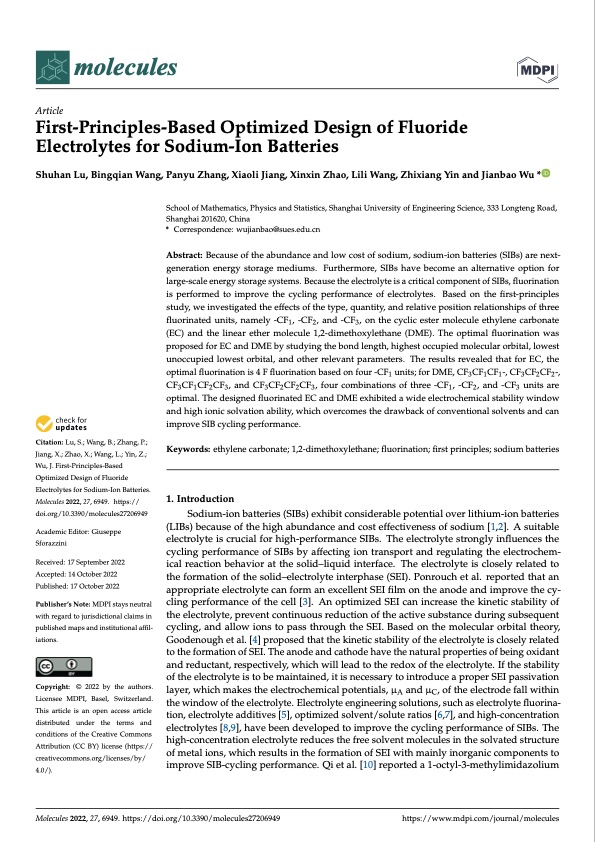
PDF Publication Title:
Text from PDF Page: 001
molecules Article First-Principles-Based Optimized Design of Fluoride Electrolytes for Sodium-Ion Batteries Shuhan Lu, Bingqian Wang, Panyu Zhang, Xiaoli Jiang, Xinxin Zhao, Lili Wang, Zhixiang Yin and Jianbao Wu * Citation: Lu, S.; Wang, B.; Zhang, P.; Jiang, X.; Zhao, X.; Wang, L.; Yin, Z.; Wu, J. First-Principles-Based Optimized Design of Fluoride Electrolytes for Sodium-Ion Batteries. Molecules2022,27,6949. https:// doi.org/10.3390/molecules27206949 Academic Editor: Giuseppe Sforazzini Received: 17 September 2022 Accepted: 14 October 2022 Published: 17 October 2022 Publisher’s Note: MDPI stays neutral with regard to jurisdictional claims in published maps and institutional affil- iations. Copyright: © 2022 by the authors. Licensee MDPI, Basel, Switzerland. This article is an open access article distributed under the terms and conditions of the Creative Commons Attribution (CC BY) license (https:// creativecommons.org/licenses/by/ 4.0/). School of Mathematics, Physics and Statistics, Shanghai University of Engineering Science, 333 Longteng Road, Shanghai 201620, China * Correspondence: wujianbao@sues.edu.cn Abstract: Because of the abundance and low cost of sodium, sodium-ion batteries (SIBs) are next- generation energy storage mediums. Furthermore, SIBs have become an alternative option for large-scale energy storage systems. Because the electrolyte is a critical component of SIBs, fluorination is performed to improve the cycling performance of electrolytes. Based on the first-principles study, we investigated the effects of the type, quantity, and relative position relationships of three fluorinated units, namely -CF1, -CF2, and -CF3, on the cyclic ester molecule ethylene carbonate (EC) and the linear ether molecule 1,2-dimethoxylethane (DME). The optimal fluorination was proposed for EC and DME by studying the bond length, highest occupied molecular orbital, lowest unoccupied lowest orbital, and other relevant parameters. The results revealed that for EC, the optimal fluorination is 4 F fluorination based on four -CF1 units; for DME, CF3CF1CF1-, CF3CF2CF2-, CF3 CF1 CF2 CF3 , and CF3 CF2 CF2 CF3 , four combinations of three -CF1 , -CF2 , and -CF3 units are optimal. The designed fluorinated EC and DME exhibited a wide electrochemical stability window and high ionic solvation ability, which overcomes the drawback of conventional solvents and can improve SIB cycling performance. Keywords: ethylene carbonate; 1,2-dimethoxylethane; fluorination; first principles; sodium batteries 1. Introduction Sodium-ion batteries (SIBs) exhibit considerable potential over lithium-ion batteries (LIBs) because of the high abundance and cost effectiveness of sodium [1,2]. A suitable electrolyte is crucial for high-performance SIBs. The electrolyte strongly influences the cycling performance of SIBs by affecting ion transport and regulating the electrochem- ical reaction behavior at the solid–liquid interface. The electrolyte is closely related to the formation of the solid–electrolyte interphase (SEI). Ponrouch et al. reported that an appropriate electrolyte can form an excellent SEI film on the anode and improve the cy- cling performance of the cell [3]. An optimized SEI can increase the kinetic stability of the electrolyte, prevent continuous reduction of the active substance during subsequent cycling, and allow ions to pass through the SEI. Based on the molecular orbital theory, Goodenough et al. [4] proposed that the kinetic stability of the electrolyte is closely related to the formation of SEI. The anode and cathode have the natural properties of being oxidant and reductant, respectively, which will lead to the redox of the electrolyte. If the stability of the electrolyte is to be maintained, it is necessary to introduce a proper SEI passivation layer, which makes the electrochemical potentials, μA and μC, of the electrode fall within the window of the electrolyte. Electrolyte engineering solutions, such as electrolyte fluorina- tion, electrolyte additives [5], optimized solvent/solute ratios [6,7], and high-concentration electrolytes [8,9], have been developed to improve the cycling performance of SIBs. The high-concentration electrolyte reduces the free solvent molecules in the solvated structure of metal ions, which results in the formation of SEI with mainly inorganic components to improve SIB-cycling performance. Qi et al. [10] reported a 1-octyl-3-methylimidazolium Molecules 2022, 27, 6949. https://doi.org/10.3390/molecules27206949 https://www.mdpi.com/journal/moleculesPDF Image | First-Principles-Based Optimized Design of Fluoride Electrolytes

PDF Search Title:
First-Principles-Based Optimized Design of Fluoride ElectrolytesOriginal File Name Searched:
molecules-27-06949.pdfDIY PDF Search: Google It | Yahoo | Bing
Salgenx Redox Flow Battery Technology: Salt water flow battery technology with low cost and great energy density that can be used for power storage and thermal storage. Let us de-risk your production using our license. Our aqueous flow battery is less cost than Tesla Megapack and available faster. Redox flow battery. No membrane needed like with Vanadium, or Bromine. Salgenx flow battery
| CONTACT TEL: 608-238-6001 Email: greg@salgenx.com | RSS | AMP |